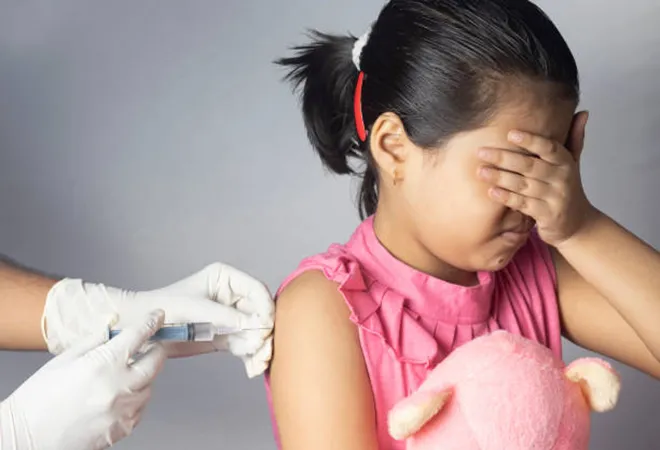
The rationale for COVID-19 vaccination
Vaccines have greatly reduced the number of deaths caused by COVID-19. They achieved this by alerting our immune system about the components of the virus—without having to go through an actual COVID-19 infection. Once long-term immune memory is formed, future responses are more balanced and proportionate. The body can get rid of the virus without suffering damage to vital internal organs. Although other benefits exist, prevention of severe disease and death remains the primary objective of vaccination.
Role of natural immunity
Natural infection by the virus also generates an immune memory, and those who survive COVID-19 are
protected against severe outcomes following subsequent infections. Countries like South Africa, with
relatively low vaccination coverage, experienced
lower mortality during the Omicron wave than in previous waves. In the absence of extensive vaccination, the protection came from prior immunity resulting from widespread natural infection in that country.
During the initial phase of the pandemic, when natural infections had not occurred amongst most people, vaccination offered a chance to acquire immunity without the risks associated with infection.
In contrast, despite having
higher vaccination coverage, Hong Kong suffered high
mortality rates from the same variant. It is worth noting that, unlike in South Africa, immunity resulting from prior natural infection in Hong Kong’s population was low, a consequence of their
zero-COVID strategy.
Changing times, changing equations
During the initial phase of the pandemic, when natural infections had not occurred amongst most people, vaccination offered a chance to acquire immunity without the risks associated with infection. However, two and a half years later, the equation is different; a substantial part of the population has already had natural infection. In 2022, having a history of multiple bouts of COVID-19 is not uncommon. A recent survey in India reported a
15 percent reinfection rate. Some countries experienced more infection than others. In other words, unlike in 2020, we are not an immune-naïve population anymore.
That being said, unlike measles or chickenpox, having antibodies against SARS-CoV2 either from vaccination or by natural infection does not provide long-term protection against infection. With new variants escaping prior immune protection,
hybrid immunity appears increasingly relevant. This is essentially an augmented immune response that occurs when the vaccine is administered to someone who had a prior natural infection.
How is vaccination in children different from that of older people?
The problem with making decisions about vaccination amongst children is that the risk-benefit equation is considerably different in this age group, unlike, for example,
adults over 60. In an older person, the death risk following COVID-19 is markedly higher. Therefore, the decision to vaccinate is more straightforward in that age segment. Besides, as the product is being given to reduce a high baseline risk, the tolerance level for adverse outcomes would naturally be higher. This is not the case with children.
The problem with making decisions about vaccination amongst children is that the risk-benefit equation is considerably different in this age group, unlike, for example, adults over 60.
The consideration of multiple related parameters in children has, understandably, resulted in polarised views on this subject. Whilst
some are vigorous advocates of
universal vaccination amongst adolescents (age 12-17), others take a more
measured approach, prioritising high-risk subgroups.
India’s child COVID vaccination programme
India’s COVID vaccination drive started on 16 January 2021 and was based on the prioritisation of risk groups. Older adults, healthcare, and frontline workers were vaccinated first, followed by other adult age groups.
Since 3 January 2022, older children in India of age 15-17 years are receiving Covaxin, an inactivated virus vaccine. Since 16 March, younger children between the age group of 12-14 have been offered Corbevax, a protein subunit vaccine. Covovax is another protein subunit vaccine that is also available for the 12-14 age group but restricted to the private sector.
Unlike certain western nations, India
does not mandate COVID vaccination, and yet has achieved close to 90% adult vaccination coverage with that approach. Vaccine uptake amongst children has also been high. For instance, in Kerala, 81% of the children in the 15-17 age group have already
received their first dose by 24 May 2022. The corresponding rate was 40% in the 12-14 age group.
What is the debate about?
Unlike dreaded diseases like polio and diphtheria that cause a high rate of serious complications including death, COVID-19 in children does not have a high fatality rate. Therefore, it cannot be compared to essential vaccines such as DPT. Besides, their limited and short-lived effectiveness in preventing infections has been a disappointment since the early days of optimism.
The problem with COVID-19 is the enormous number of infections occurring during a wave, and vaccination is done with the hope to reduce the overall impact. At the same time, unlike adults, children cope with COVID-19 quite well, with
death rates below one in two million. This is believed to be in part due to their excellent innate immune response which gets rid of the virus early, without having to stress out the other arms of the immune system.
The problem with COVID-19 is the enormous number of infections occurring during a wave, and vaccination is done with the hope to reduce the overall impact.
In an evolving pandemic, it is not always possible to measure or communicate risk and benefit in absolute terms. Consequently, discussions about the vaccination of children tend to generate a wide range of responses from experts as well as the general public. On the one hand, there were concerns about the universal use of a partially effective vaccine against infection with a low complication rate in this age group, in a population that has already achieved high seroprevalence. On the other hand, others were not convinced about leaving children out whilst adults were getting vaccinated during the pandemic.
Most of the published literature on paediatric vaccination is based on mRNA vaccines in western nations with different population dynamics, and hence might not be directly applicable in the Indian context.
How many doses of vaccine are needed to prevent one serious outcome of COVID-19?
While it might seem logical to vaccinate everyone and try to prevent even very rare serious outcomes, it is also important to have an idea of the denominator, as no medical intervention is without risk.
In a risk-benefit analysis of COVID-19 vaccination among children, JCVI (Joint Committee for Vaccination and Immunization) the UK estimates that
4 million doses of vaccine have to be given to two million children in the 5-11 age group, for one ICU admission to be prevented.
The question is whether we have adequate safety data about vaccines in children that ensures that none of these two million children will go to hospital as a result of an adverse outcome.
The available published data on vaccines currently used in India for children do not raise any safety concerns. Inactivated and subunit vaccines are established platforms for paediatric vaccines.
However, published
studies for COVID vaccines used in India are
based on a few
hundreds of children, and will not be sufficient to detect or study rare outcomes. For instance, myocarditis occurs in
1: 6637 males of age 16-19 after the second dose of mRNA vaccine: such cases could be missed while studying smaller numbers of trial participants.
MIS-C, a rare complication
One of the delayed complications from COVID-19 amongst children is MIS-C, an acronym for Multisystem Inflammatory Syndrome in Children. Although, infrequent in occurrence and predominantly seen in
younger children, this condition can rarely lead to serious outcomes. The published death rate from MIS-C is less than
one in a million children. It is hoped that vaccination can prevent this, but questions remain.
The medical literature is not consistent about how common this condition is, partly because of the ill-defined criteria used for diagnosis, and due to methodological issues with studies conducted.
The first is that vaccination is not a guarantee against infection. Breakthrough infections are common, raising the possibility of MIS-C happening even
amongst vaccinated children.
The second is that in extremely rare instances, MIS-C can occur apparently as a
direct result of
vaccination.
Third, there is evidence that MIS-C is becoming
less common with repeated waves of infection, especially since the
arrival of new variants such as Omicron. This could be due to protective immunity arising from the
previous infection. Paediatricians in India too have observed this pattern.
At this time, in western nations, it is believed that MIS-C is less likely to occur among those who are vaccinated. Recent data on the incidence of MIS-C from countries with
high rates of seroprevalence like India are not available.
Long COVID
The persistence of symptoms past 12 weeks of the initial infection is termed Long COVID. Although, more common amongst younger adult women, Long COVID can occur in any age group, including children. One of the reasons increasingly heard being mentioned in support of child vaccination is to reduce the risk of Long COVID.
Unfortunately, the medical literature is
not consistent about how common this condition is, partly because of the ill-defined criteria used for diagnosis, and due to methodological issues with studies conducted. Some studies say it is common, others find it is rare. Research from Europe has shown that symptoms described in Long COVID can occur at a
similar frequency amongst
children and
adults who
did not have SARS-CoV2 infection.
Feedback from school teachers during focused training sessions, and discussion in forums with paediatricians practising in India have indicated that despite large numbers of COVID-19 infections amongst children, complications and long COVID remain rare.
Published studies on the incidence of long COVID among children in India are not available. Feedback from school
teachers during focused training sessions, and discussion in forums with paediatricians practising in India have indicated that despite large numbers of COVID-19 infections amongst children, complications and long COVID remain rare. However, these estimates will not reveal the true extent of Long COVID in the community because children need not always report symptoms to their parents or teachers.
Although there is published evidence now that Long COVID can be
prevented to some extent by vaccination, there are robust studies that suggest
otherwise.
Current practice
Vaccination of children in the 12-17 age group against COVID-19 is a standard practice in many nations, and India is no exception. Indian Academy of Paediatrics
endorses the programme, emphasising the prioritisation of children in high-risk groups, both by comorbidity and also for children living with adults having high-risk conditions.
Several
nations have also initiated COVID vaccination for younger children in the 5-11 age group, although the uptake is
lower. COVID-19 vaccination of children below the age of 12 has not commenced in India at the time of writing this article.
The views expressed above belong to the author(s). ORF research and analyses now available on Telegram! Click here to access our curated content — blogs, longforms and interviews.




 PREV
PREV


